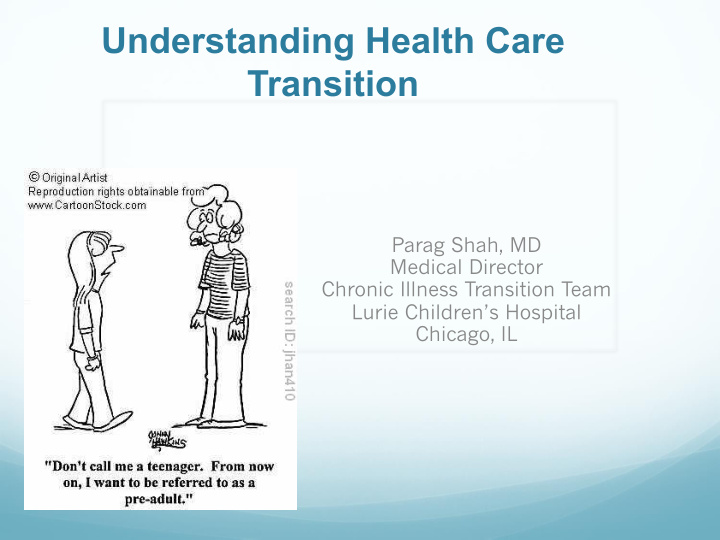



Understanding Health Care Transition Parag Shah, MD Medical Director Chronic Illness Transition Team Lurie Children’s Hospital Chicago, IL
DISCLOSURE SLIDE I work as a physician at Ann and Robert H. Lurie Children’s Hospital of Chicago, and I have no financial or commercial disclosures relating to this presentation. 2
Objectives What do we mean by “ Transition ” Facts, Challenges, Barriers Tips and Resources
Transitions HEALTH CARE TRANSITION “ the purposeful, planned movement of adolescents and young adults with chronic physical and medical conditions from child-centered to adult-oriented health care systems. ” (AAP Clinical Report 2011)
Facts About Transition ¡ Most make this transition without systematic preparation § Only 16% of children claim transition services discussed explicitly § 60% of parents with YSHCN reported not receiving necessary services to make appropriate transitions § Less than 50% of pediatricians report assisting in transition of CYSHCN most of the time § (CMH) 11% with portable medical summaries, 23% with adult care plan *American Academy of Pediatrics. Survey: Transition Services Lacking for Teens with Special Needs. AAP News. Vol 30; 2009.
Known Barriers ¡ Pediatric Providers have reported § Lack of adult physicians to care for young adults with chronic illness § Lack of adult physicians with knowledge of pediatric diseases § Poor reimbursement § Their own reluctance Adult Providers have reported Lack of training Difficulty meeting psychosocial needs Lack of time and reimbursement Lack of coordinated transfer from pediatric practices Families and Patients have reported Differences in culture between pediatric and adult health care models Nervousness about going to somebody that “ doesn ’ t know anything about me ”
Pediatric vs Adult Models of Health care Adult Pediatric •Provider & parent •Patient responsible controlled •Multiple providers each •Comprehensive, caring for separate issues multi-disciplinary clinics (one-stop-shopping) •Less social work or case management •Case management & assistance social work support •Patient must be proactive •Families supported to get services through process
When Should Transition Begin? ¡ Ages 11-13 ¡ Youth most receptive to future planning ¡ Less gap between peers
Assessing and Preparing Youth ¡ Knowledge ¡ Skills ¡ Responsibilities USE A CHECKLIST TO HELP (CREATE ONE FOR YOUR POPULATION)
Checklist Example
KNOWLEDGE ¡ Name of your condition ¡ Names of your medications (Bring medication list with specific instructions from pharmacy) ¡ Names and contact information for your providers ¡ Importance of hand washing ¡ Anesthesia precautions ¡ Hydration protocols ¡ E.g. No Lactated Ringers
Examples - Knowledge ¡ Have patient describe ¡ You are about to transfer care of their illness in 3 a patient to a new adult doctor. What are some things you can do sentences to ensure your patient knows ¡ Have them learn about about their condition? their medical history from their parent, major hospitalizations, surgeries, medicines etc. ¡ Have patient create a portable medical record
Skills ¡ Make an appointment ¡ Filling prescriptions ¡ Ordering meds & supplies ¡ Care and access of central lines or enteral feeding tubes
Examples - Skills ¡ Speak directly to patient so It has been a year since your they can learn to communicate patient ’ s last appointment with their specialist, you want to start teaching ¡ Direct patient to front desk to your patient to become more make the appointment independent. What can you do? themselves ¡ Have patient prepare some questions to ask the doctor about their condition
Responsibility ¡ Gradual shift in responsibility from caregiver to teen ¡ Teen going from consultant to manager to CEO Provider Parent/Family Young Person Early - Major responsibility -Provide care -Receives care -Support to -Manages -Participates parent/family & Middle child/youth -Consultant -Supervisor -Manager Late -Resource -Consultant -Supervisor
ADHERENCE ¡ Ask directly about barriers ¡ You are trying to encourage more compliance with your patient. ¡ Use resources (technology, pill What can you do? boxes) to help improve compliance
Assessment of Youth OTHER ITEMS ¡ Guardianship ¡ Power of Attorney vs Guardianship ¡ Financial, health care, estate ¡ Insurance, Benefits, and future financial planning ¡ Community Resources § Pediatricians feel lack of knowledge of community resources is large barrier to transition § Community participation has strong association with successful transition
Portable Medical Record
My Health Passport http://www.sickkids.on.ca/myhealthpassport
Electronic Health Record http://www.americanmedical-id.com
INSURANCE: THE GOOD, THE BAD, THE UGLY ¡ Insurance can be a significant barrier of transition. Uninsured rates are 29% for young adult compared with 14% national average ¡ There are a variety of insurance options for children and adults ¡ Insurance will change for our adult patients ¡ Most dependents can now stay on insurance until they are 26 years old
Supporting patients who lose insurance ¡ Provide anticipatory guidance to plan for insurance needs as an adult. www.Healthcare.gov ¡ Social workers can provide resources to legal/advocacy support § Ex. Health & Disability Advocates can help appeal a SSI and Medicaid denial. ¡ Patients without insurance may be eligible for medication prescription programs § Ex. www.needymeds.org 22
Tools: Transition Resources ¡ Health Care Checklists ¡ Medical Health Summaries ¡ Transition Websites ¡ Transition Videos
My Med Schedule www.mymedschedule.com
LURIE CHILDREN ’ S SITE HTTP://WWW.LURIECHILDRENS.ORG/EN-US/CARE-SERVICES/FAMILY- SUPPORT/TRANSITIONING-TO-ADULT-CARE/PAGES/DEFAULT.ASPX
FUTURE DIRECTIONS Developing formal checklist of knowledge and skills for your population Development of a comprehensive resource website such as foundation website etc. for families Development of 1 page fact sheets for providers surrounding issues of mitochondrial diseases Understand the most common issues surrounding issues such as guardianship, driving, insurance coverage and develop letters and forms that providers can use to help their families Locate community resources that can help young adults meet peers and engage in their community to the fullest extent (local) 26
THINGS TO REMEMBER… Transition involves planning for teens’ future in school and work, community, relationships and medical care Transition is a process not an event Start early!
Contact Information ¡ Rebecca Boudos, LCSW § rboudos@luriechildrens.org ¡ Parag Shah, MD § Pshah@luriechildrens.org
Recommend
More recommend